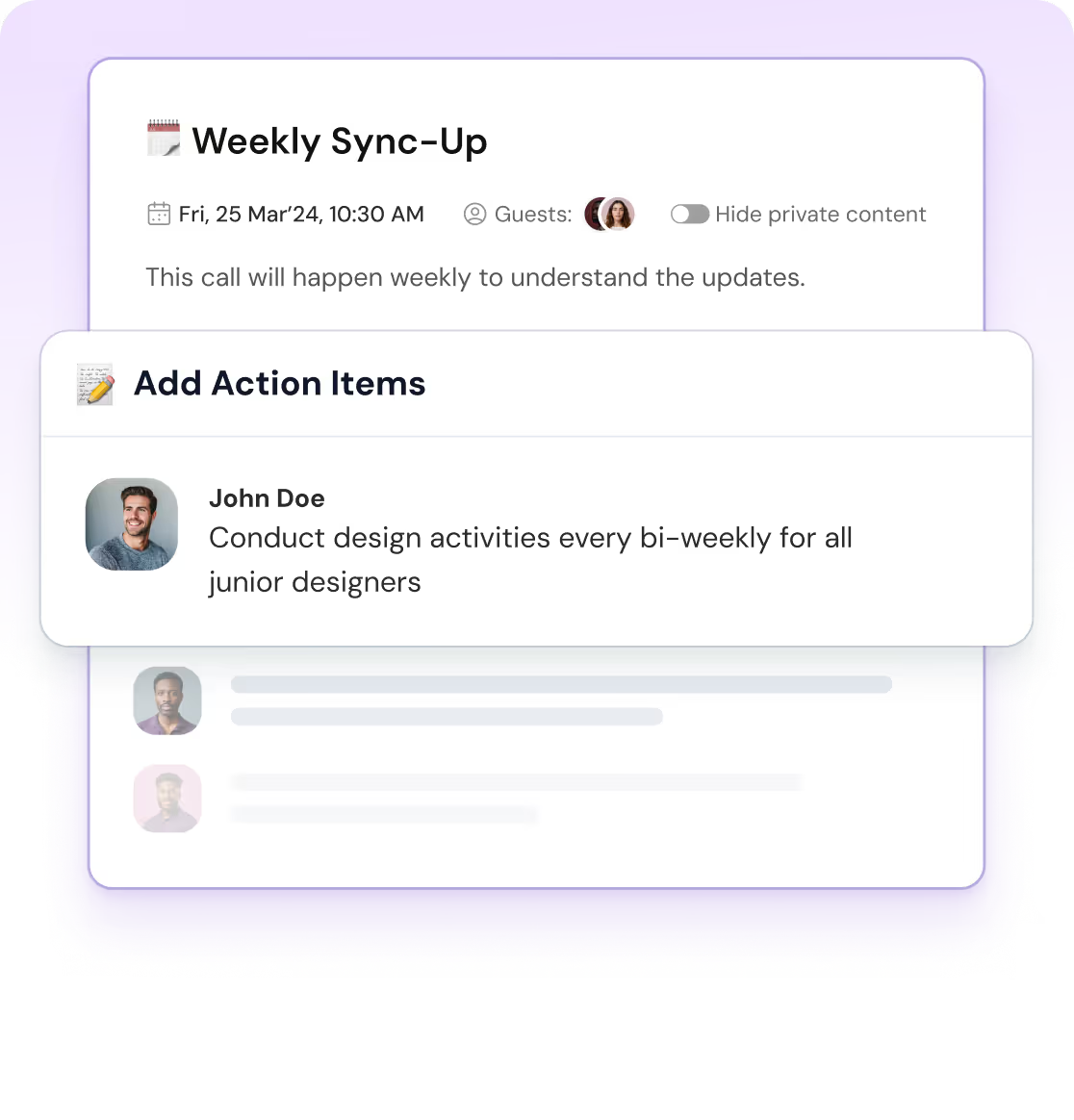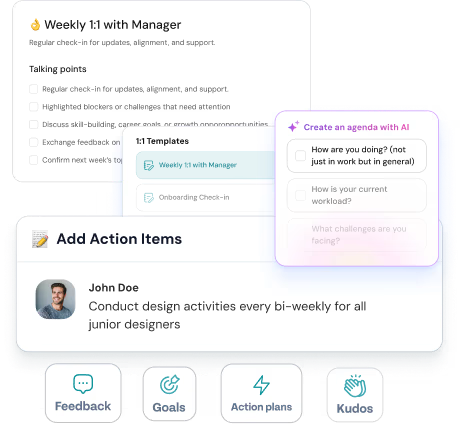Are you someone who believes one-on-one meetings are a bit too bossy and intimidating for employees?
Well, it’s not as rigid as it sounds.
Such meetings help build a proper bond between managers and employees, enabling them to understand each other.
Individual meetings are crucial to any company's success. These sessions are crucial for open communication between managers and workers, which boosts teamwork and organizational coherence.
Managers must hold effective one-on-one meetings to improve their employees' careers and maximize their potential. Let's discuss the benefits of conducting one-on-one meetings and look at 10 tips that help you and your employees get the most out of these meetings.
What is a One-on-One?
A one-on-one meeting is a discussion between two employees, where discussions about work happen.
These meetings mostly happen when an employee wants feedback or wants to provide feedback, and discuss how to overcome challenges. Another situation when one-on-ones happens is during performance reviews.
At this meeting, the manager reviews the employees' performance and disusses their compensation and growth plans based on performance. The employee can if any talk about the challenges he's facing and any other suggestions relating to improving productivity and systems.
Benefits of One-on-Ones
One-on-one meetings enhances communication, teamwork, and employee growth.
It provides a platform for open dialogue, enabling managers to understand their employees better, and offer guidance. Don't delay these valuable sessions – they foster a supportive, united work environment.
It also helps each individual know that the organization takes their thoughts and feelings into account.
When individuals feel that way, they work more and stay longer. When Adobe switched up their one-on-one meetings to every two weeks, they benefitted from a 30% reduction in voluntary turnover.
One-on-one meetings between managers and their team members may not address all issues, but they can be a powerful tool for managers to tackle common workplace challenges, including:
- Improper communication
- Lack of constructive feedback
- Stunted personal and career growth opportunities
- Declining trust in management
- Unresolved concerns
- Interpersonal and interdepartmental disputes
- Uncertain job objectives
One-on-one meetings are essential for workplace communication and engagement. Here are 10 tips for getting the most out of these interactions.
1. Establish a routine
Consistency builds trust. Set a cadence that works for both you and your team — weekly, biweekly, or monthly. A predictable schedule helps employees prepare, reflect, and speak openly about challenges or wins. Even a short 30-minute Friday check-in can make a big difference.
2. Create a safe, positive space
Psychological safety is the foundation of a good one-on-one. Make it clear that the conversation is a judgment-free zone where employees can share ideas, concerns, or struggles honestly. When people feel safe to speak, they’re far more likely to bring their best thinking to the table.
3. Always come prepared
Don’t wing it. A simple agenda shared ahead of time helps both sides focus on what matters most. Encourage employees to add their own topics too.
This keeps the meeting balanced and ensures you make the most of every minute together.
4. Focus on growth and development
Use one-on-ones to talk about more than just projects; talk about careers too. Ask them about their goals, learning interests, and what support they'd need to get there. Offer constructive, actionable feedback, and align their aspirations with team and company priorities.
ThriveSparrow’s 360° feedback platform make this even easier by pulling input from peers, managers, and self-evaluations to give employees a complete picture of their strengths and opportunities to grow.
5. Ask open-ended questions
Great one-on-ones start with great questions. Avoid yes/no prompts and aim to understand your employees on a deeper level.
For example
Instead of asking, “Are you happy with your project?”, try “What part of your current project excites you most — and what’s been challenging?”
Curiosity leads to clarity — and better coaching moments.
Here are 19 such questions that every leader should ask their employees to improve performance, and enhance engagement.
6. Follow up on past conversations
Accountability builds credibility.
Start each session by revisiting the last one: What progress was made?
What roadblocks remain?
Celebrate wins, address concerns, and keep track of follow-ups. It shows you’re paying attention — and that their work matters.
7. Celebrate the wins
Recognition doesn’t need to wait for an all-hands.
You can use one-on-ones to call out achievements, be it big or small. A few genuine words of appreciation can go a long way in keeping morale high and reinforcing positive behaviors.
8. Address issues thoughtfully
Difficult conversations are inevitable, but how you handle them defines your leadership.
Tackle performance or behavioral issues privately, respectfully, and with context.
Stick to facts, not assumptions.
Ask questions before giving advice. And always make sure the employee feels supported, not cornered.
9. Encourage two-way feedback
One-on-ones shouldn’t be a monologue.
Ask employees how things are going — with the team, the process, or even your leadership. Take feedback with grace and act on it.
When employees see you listening and adapting, it reinforces a culture of openness.
Anonymous tools like ThriveSparrow make this even more seamless. Managers can run quick, anonymous feedback surveys to understand team sentiment without bias or hesitation — helping to build trust and transparency.

👉 Create your first anonymous survey in minutes with ThriveSparrow’s research-backed question banks. Explore ThriveSparrow for free today and turn feedback into action.
Start your free trial now.
10. Respect others' privacy and time
Trust is built in small moments — like starting on time, keeping commitments, and maintaining confidentiality. Never reschedule one-on-ones unless absolutely necessary, and never share what’s discussed without consent.
A consistent, respectful approach shows your employees that their time, and their trust, truly matter.
Common One-On-One Mistakes to Avoid
One-on-one meetings with managers are surely useful, but every manager should be aware of several pitfalls they must avoid in order to guarantee the effectiveness of such meetings. Avoid these common mistakes:
1. Showing up unprepared
A one-on-one without preparation is a wasted opportunity. Review the employee’s recent work, goals, and previous notes before the meeting. Walking in unprepared sends the message that their time and effort isn’t valued.
2. Doing All the Talking
A good one-on-one isn’t a monologue. It’s a conversation. Give employees space to share updates, concerns, and feedback. Listen more than you speak — and resist the urge to jump in too quickly. Remember: the goal is understanding, not airtime.
3. Focusing Only on the Negatives
Constructive feedback matters, but too much criticism can crush motivation. Balance your discussions with recognition and encouragement. Highlight what’s working before diving into what needs improvement — that’s how you build confidence and trust.
4. Ignoring Growth Conversations
Don’t let performance updates crowd out career discussions. Employees want to feel that they’re growing, not just producing. Spend time exploring their goals, skills they’d like to develop, and where they see themselves next. These moments create loyalty.
5. Canceling or Rescheduling Too Often
Nothing kills momentum faster than canceled one-on-ones. Frequent postponements make employees feel like the meeting and by extension, they aren’t a priority. If you truly must reschedule, do it early, explain why, and make it up promptly.
6. Dismissing Employee Input
Encouraging feedback is easy. Acting on it is what counts. When employees share suggestions or concerns, acknowledge them, take notes, and follow up later. Doing nothing tells them their opinions don’t matter and engagement drops fast.
7. Skipping Goal Setting
Without clear goals, one-on-ones drift into vague check-ins that don’t lead anywhere. End each session with at least one actionable goal. It should be something measurable that ties back to their role or development plan. Clarity builds accountability.
8. Using the Meeting to Micromanage
A one-on-one isn’t a task audit. Avoid dissecting every to-do item or hovering over small details. Instead, focus on progress, blockers, and support. Micromanagement stifles ownership, guidance inspires it.
Turn Every One-on-One into a Growth Moment
The best one-on-ones don’t just happen — they’re built on structure, feedback, and trust.
With ThriveSparrow, you can streamline that process.
From tracking discussion themes to surfacing employee sentiment through anonymous feedback, ThriveSparrow helps you create one-on-ones that actually move the needle — for performance, growth, and engagement.

Start your 14-day free trial today and explore ThriveSparrow.
FAQs
1. What are the benefits of one-on-one meetings?
One-on-one meetings include several advantages such as:
- Enhanced communication
- Increased employee engagement
- Improved relationships with each team member
- Increased productivity
- Accurate feedback and actionable tactics
2. What should a one-on-one meeting include?
A one-on-one meeting should include an open conversation between a manager and an employee. It's a chance to discuss goals, provide feedback, address concerns, and promote professional growth.
3. What is the importance of one-on-one meetings?
One-on-one meetings fosters communication, trust, and understanding between managers and employees. They enhance teamwork and employee morale, leading to a more cohesive and productive workplace.
4. What is the meaning of one-on-one discussions?
A one-on-one discussion is a private, individualized conversation between a manager and an employee. It allows both parties to exchange ideas, feedback, and insights, promoting collabaration and fostering a better working relationship.
5. Should you worry if your boss schedules a 1:1?
It is normal to be worried, as many think that it is going to a negative feedback session. But the purpose of one-on-ones is to discuss obstacles and work through them together. One-on-ones are not just conducted between you and your manager, they can be done with any of your peers to discuss how to overcome challenges together with them as well.
















